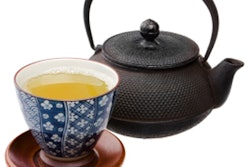
The oral health benefits of green tea are getting increasing attention in scientific literature, and now the authors of a new study suggest that it should be added to dentifrices as an active ingredient for managing periodontal disease.
The study authors, who are associated with various medical institutes in India, reported that it is a beneficial adjunct to nonsurgical periodontal therapy.
A dentifrice containing green tea significantly reduced inflammation in patients who had undergone scaling and root planing, and it also improved the antioxidant levels in gingival crevicular fluid, they reported in the International Journal of Dental Hygiene (February 17, 2015).
"Green tea is known to possess anti-inflammatory, antibacterial, and antioxidant activities," the authors wrote. "Antioxidants have a protective effect on periodontal tissues by reducing the oxidative stress in periodontal tissues."
There has been interest in the usefulness of green tea for treating periodontal disease, but clinical trials with green tea dentifrice for managing gingival inflammation in periodontitis are limited, they added.
While local drug delivery of green tea extract has shown promising results in treating periodontal diseases, professional help is needed for delivering green tea catechins to periodontal pockets, the authors noted. They recommend that dentifrice and mouthwashes be used for this purpose.
The researchers evaluated the effect of a locally prepared green tea dentifrice after scaling and root planing in patients with mild to moderate chronic periodontitis. The dentifrice was prepared at the Manipal College of Pharmacy using green tea extract with 60% to 90% of epigallocate-chin-3-gallate (EGCG).
The study included 30 people with mild to moderate periodontitis who reported to the department of periodontology at Manipal College of Dental Sciences. All of them had at least six sites with probing pocket depth (PPD) of greater than 4 mm with clinical attachment loss of 1 mm to 2 mm (mild periodontitis) or 3 mm to 4 mm (moderate periodontitis).
The study participants were randomly divided into two groups of 15; all participants received full-mouth scaling and root planing. Patients in the test group were asked to use the green tea dentifrice, while those in the control group used a commercially available dentifrice with fluoride and triclosan. All participants were asked to brush twice daily and told to not use other interproximal aids.
The researchers recorded clinical and biochemical parameters, including gingival index, plaque index, percentage of sites with bleeding on probing, probing depth, and clinical attachment level. This was done before scaling and root planing and then at a four-week recall.
They also recorded the biochemical parameters of total antioxidant capacity and glutathione-S-transferase activity in gingival crevicular fluid at baseline and four weeks after treatment.
The researchers found that the mean change between baseline and four weeks post-therapy for the gingival index was significantly higher in the test group. At baseline, it went from around 1.73 in the test group and 1.58 in the control group to 0.96 in the test group and 1.04 in the control group at the four-week follow-up.
Both groups showed a significant mean reduction for plaque index at four weeks, and no differences were observed between groups for this clinical parameter. It was reduced from around 1.60 to 0.85 in the test group and from 1.61 to 1.08 in the control group.
For the bleeding on probing parameter, the test group showed a significant improvement over the control group. The researchers found a statistically significant reduction from 84.38% to 25.0% in the test group and from 78.12% to 31.25% in the control group.
They found no significant difference in probing depth reduction, but found that the gain in clinical attachment level was significantly higher in the test group.
The total antioxidant capacity in gingival crevicular fluid showed significant improvement at four weeks in both groups. However, the increase was significantly higher in the test group. The mean glutathione-S-transferase activity in the control group did not show any change at baseline and the four-week follow-up, but it did show an increase in the test group.
"On comparison with fluoride-triclosan dentifrice, green tea showed greater reduction of gingival inflammation and improved periodontal parameters," the authors wrote. "This can be attributed to the antibacterial, anti-inflammatory, and antioxidant properties of green tea."
These results show that the use of green tea dentifrice as an adjunct to scaling and root planing during the active and healing phases following periodontal therapy can enhance outcomes, they concluded.
Long-term clinical trials should be conducted to validate the results of this pilot study, they added.



















